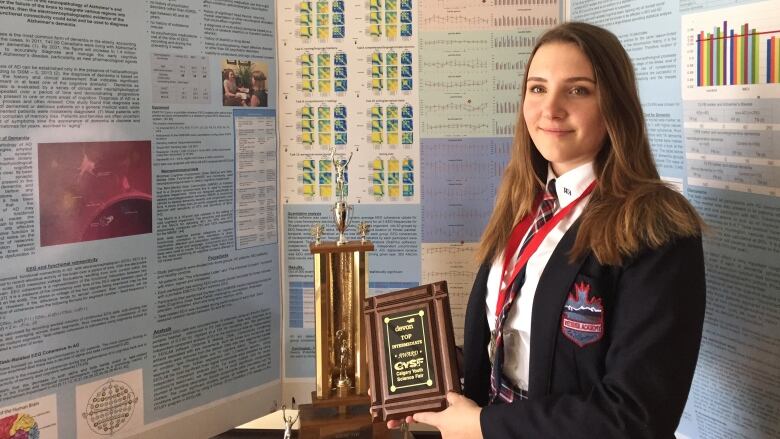Curing HIV and diagnosing Alzheimer's: High school science fairs get serious
'It's just the new possibilities are endless, essentially anything you want to do you can always do'

Gone are the days ofhigh school science projects that featured misfiringspace rockets and mouldgrowing on food.
These days, Calgary students likeEmily Gubskiand CrystalRadinski are elevating science fairsto ground-breaking heights. Their projects could lead to a cure for HIV or a test that diagnoses Alzheimer's much earlier in order to improve a patient's quality of life.
Both of the students' projects sound like something an experienced PhD researcher would be working on. Theirimpressive projects have earned them a spot at the Canada-Wide Science Fair,May 14 to 20 in Regina.
DNA mutation
A Grade 12 student at Sir Winston Churchill High School student, Gubski's project focuseson helping people with HIV.
"I'm trying to find a way to mutate a segment of the DNA in an HIV patient in order to make them immune to HIV," Gubski told the Calgary Eyeopener on Wednesday.
Her project explores amutation called Delta 32that occurs in one per cent of the Caucasian population."How it works is that a certain part of the DNA in your regular immune cells don't exist," she said.
"So they are lacking a certain receptor that's necessary to HIV infection. So if I can induce this mutation in the T cells of HIV patients, then once the T cells split a second time or third time they will become immune to HIV as well. And over time you will actually get an immunity build up in a patient."
Volunteer stint leads to project
Radinski'sproject idea was influenced by a volunteer stint she did at a geriatric clinic working with Alzheimer's patients.
Watching the nurses, theGrade 10 student at Webber Academy observed thatdiagnosing Alzheimer's was tedious and time-consuming. Because the disease develops over many years, she was curious if there was an easier way.
She contacted people who worked in the field and says everyone was eager to help and the project developed from there.
She started recording electrical activity in the brain using an EEG on patients with a healthy brain and onpatients with dementia.
"Comparing them, you can find the area of disconnection which occurs in dementia," she says.
'Possibillities are endless' for students
Both students say their projects have been easier to pursue with the supportive educational environment for high school students in Alberta.
"You can get a lot of help with any idea you might have," says Radinski.
"You're able to try new things. It's just the new possibilities are endless, essentially anything you want to do you can always do."
Radinski says her interest in the "fuzzy" area of brain research will hopefully lead her to become aneuro-psychologist or neurosurgeon.
For Gubski, the science fair is just the beginning of what she hopes will be a long career in immunology or microbiology.
- MORE CALGARY NEWS |Sorry, beaver: Wolf leads the pack in Calgary Zoo's Greatest Animal contest
- MORE CALGARY NEWS |They're baaaack: Goldfish spotted in Okotoks storm ponds once again
With files from the Calgary Eyeopener












_(720p).jpg)


 OFFICIAL HD MUSIC VIDEO.jpg)
.jpg)



























































































